Revolutionary War Battles
Contents
Lexington/Concord
Fort Ticonderoga
Bunker Hill
Canada
1776
Brooklyn Heights
Long Island
White Plains
Fort Washington
Fort Lee
Trenton
1777
Princeton
Oriskany
Bennington
Brandywine
Paoli
Saratoga @ Freeman's Farm
Saratoga @ Bemis
Germantown
1778
Monmouth
Savannah
1779
Savannah
Sunbury
Stony Point
Paulus Hook
1780
Charleston
Camden
King's Mountain
1781
Guilford Courthouse
Eutaw Springs
Yorktown
Chapter 2
1778-1781
(Chapter 1--1753-1777)
The New Year was to witness two major engagements and a series of lesser battles and skirmishes no less deadly, but none with the longer term consequences than Monmouth, New Jersey and Savannah, Georgia.
In February of the New Year, the patriots scored a diplomatic success at the French Court. Benjamin Franklin entered into a formal treaty of aid with the French government. The secret agreement was short lived as the English spies in the French Court, almost immediately, were aware of its terms. That was the starting gun, so to speak, and the respective navies of these large European nations were already engaging each other on the high seas.
It was merely a formality when the French declared war on Great Britain on July 10. Shortly, thereafter, French ally, Spain, followed suit and declared war on Great Britain.
Revolutionary War Battles
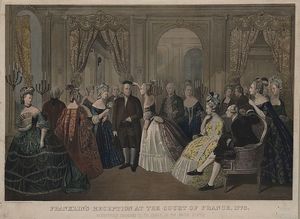
(Library of Congress)
April 24: The Continental Navy Ranger, an 18 gun corvette commanded by John Paul Jones, engaged HMS Drake in the Irish Sea. The Drake was a 14 gun converted vessel commanded by Captain George Burden who died in the hour long battle. The American crew boarded the British vessel and sailed her to France as a prize of war. The first victory of an American ship in Britain’s back yard.
May: British forces, desperate for supplies, burned and pillaged Bordentown, New Jersey.
June: British abandoned Philadelphia.
Revolutionary War Battles
Monmouth
June 28: General Clinton moved his Philadelphia troops back to the New York area.
General Washington chose the Monmouth, New Jersey area to field a 5,000 man American force to oppose Sir Henry Clinton. Washington chose Major General Charles Lee to lead with a supporting cast of the regiments of Generals Nathanael Greene, Anthony Wayne and Lafayette.
Lee was initially reluctant to assume the command. Unfortunately, he had a change of mind when Lafayette was chosen as an alternate. Lee, from the start, had little control of the battlefield. He failed to initiate orders to regiments that could have decimated Clinton’s rear guard. Clinton recovered and the British counterattack sowed panic in the American ranks. Lee ordered a retreat. George Washington arrived and personally removed Lee from command and brought order to the fleeing Americans. The presence of Washington raised morale and strengthened the confidence in the army in General Washington's leadership.
General Lee was convicted at a court martial and dismissed from the service.
Revolutionary War Battles
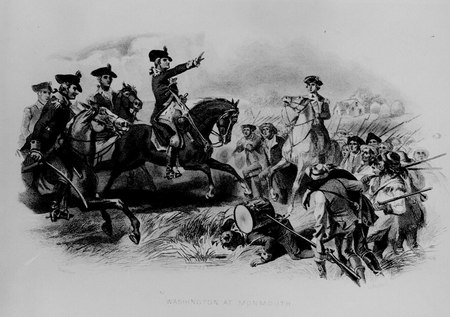
(National Archives)
Washington ordered Wayne to halt the British advance. The Americans had been trained by Von Steuben’s in European drill methods and it bore fruit. The Americans stood fast and restored order to the battle field. The armies had fought to a draw in 100 degree heat. Casualties were roughly equal of about 300 each.
A sidebar of history records that some American women attended the American troops with pitchers of water to relieve them from the heat of the day. About 100 men died of heat exhaustion. The name “Mary Pitcher” emerged from this story and Mary Hays attending her husband may have sparked the story.
British General Clinton, after a draw in New Jersey and the loss of General Burgoyne in
New York, turned his attention to a Southern Strategy. Another impetus
for looking south was the official French entry in the war with their attendant
naval power July 10. Clinton determined that quick victories in the south would preclude French help for the Americans.
June: Virginia sought western expansion and dispatched Lt. Colonel George Rogers Clark to capture and annex property in the Northwest Territories. He successful captured, without bloodshed, the British fort at Kaskaskia. Further, he was able to gain the loyalty of the population of Vincennes. Although there was some backsliding on the loyalty oath, the territory was renamed “Illinois”. The significance of the Clark expedition exceeded the exploits on the ground. The British lost their foothold in the territories, and this was reflected in the peace treaty of Paris in 1783. (Clark’s younger brother cemented the family reputation in the famous Lewis and Clark expedition of discovery in 1804-1806.)
|
Revolutionary War Battles 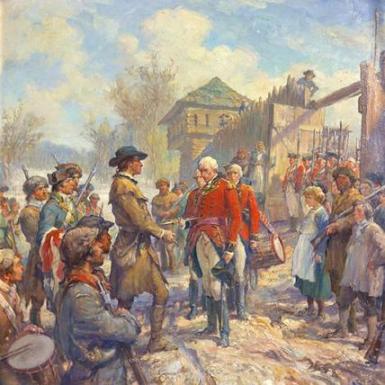 |
Revolutionary War Battles 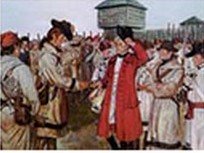 Kaskasia. . . . . .....-------Vincenne (Kentucky National Guard) |
September: British raided Martha’s Vineyard. One of several raids in Massachusetts to gain basic supplies to sustain the British army.
September: French Admiral Valerie D’Estaing, following his country’s Declaration of War on Great Britain July 10, actively attacked British shipping and outposts in the Caribbean Sea. This further strained British resources.
Revolutionary War Battles
Savannah
December: The 1778 northern winter had suspended military operation in that theater. Then, General Clinton pointed his forces southward. That started in November with an uptick of raids in South Carolina. On December 28,, 600 Americans manned the Savannah, Georgia garrison. There was a mixed force of militia and Continental Army units under Major General Robert Howe. He had recently arrived from neighboring South Carolina and assumed command.
The British intent was to drain Continental strength in the south. The plan required joining forces with Brigadier General Augustine Prevost marching north from East Florida with his force and allied Indian tribes.
American, Robert Howe, set up a defensive line in a swampy area in order to block an advance of 3,000 disembarked British troops. Much of the swamp was impassable. British Lt. Colonel Archibald Campbell enlisted the aid of a knowledgeable slave who led his soldiers to safe passage through the swamp. His bayonet charge routed the surprised Americans. Many of the escaping may have died of drowning. 450 Americans were captured. Charges were brought against Robert Howe for loss of the city. He was acquitted.
Campbell had spent about two years in American captivity and was released in an exchange for American patriot, Ethan Allen.
|
Revolutionary War Battles 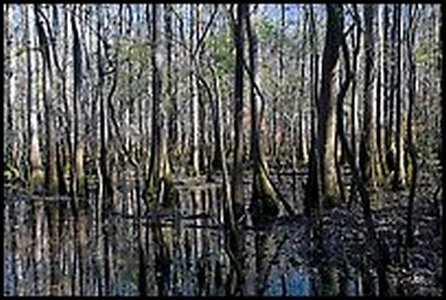 The benign Campbell portrait belies the fierce warrior in a Georgia swamp. |
Revolutionary War Battles 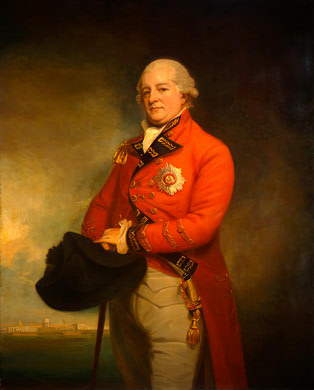 |
"The rest of the story"-----nine months later---the American battle plan to retake Savannah--- another failure as described below.
Revolutionary War Battles
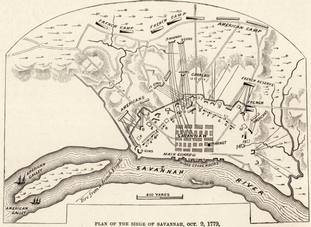
The American plan was to recapture Savannah now under the rule of General Augustine Prevost.
The strategy was to combine a naval operation under French Admiral Comte D’Estaing and land forces led by Major General Benjamin Lincoln. Prevost had learned the lesson from the previously unprepared American garrison. He began to strengthen the defenses of the city.
The Comte D’Estaing's French fleet arrived at the point when the Prevost defenses were incomplete. Historians believe that if the French Admiral had landed his troops he could have literally walked into the city and recaptured it.
However, he decided to await the arrival of Lincoln’s troops. That decision led to a fierce battle that began on September 1 and concluded on Oct 18 in a bloody confrontation. The Americans were repulsed and lost the chance to recapture the city. The total American casualties were about 1,000 and 155 for the British. Lost in an American cavalry charge was General Casimir Pulaski, Polish born, who had embraced the American cause.
Revolutionary War Battles
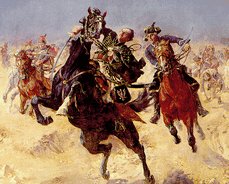
(Polish Museum of America)
The British northern strategy in 1779, devised by Lt. General Henry Clinton, was dependent on the military opportunity provided by a willing Washington to expose his army in an all out open field battle. Washington did not oblige. Clinton’s alternative plan was to raid, burn and limit attacks in their northern colonies. His northern focus was to attack American forts along the Hudson River. These posts posed obstacles for British passage to the up river highlands and exposed American strongholds. In many of those sites, the terrain was not conducive to large open field battles favored by European armies. The Americans had forged a huge chain that stretched across the Hudson River to block British warships. The attempt was ineffective.
Revolutionary War Battles
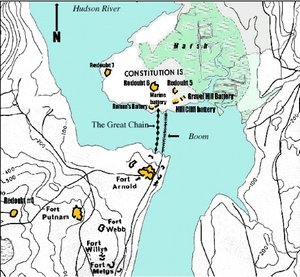
(United States Military Academy)
The policy makers in London continued to press General Clinton to shift emphasis to the south where there were numerous clashes between the patriots and loyalists. These mother country sympathizers were more mobilized than their northern brethren. The British recognized their importance. Thus they were receiving support from regular army forces based in northeastern Florida (St. Augustine) under the command of Augustine Prevost.
Revolutionary War Battles
Sunbury
a/k/a Fort Morris
January: When Savannah
surrendered to the British on December 28, 1778, it was inevitable that Fort Morris would be attacked. The fort was commanded by Major Joseph Lane
with a small garrison of Continental Army and militia. They were surrounded by 2,000 British regulars
and Loyalists. After a bombardment and shelling over a 3 day period, the fort
fell on January
9. American causalities were 4 killed, 7 wounded and 200 captured;
British dead1, 4 wounded.The British attack was led by Lt. Colonel Archibald Campbell attached to the army
of General Augustin Prevost and the victor in the first battle of Savannah.
"The rest of the story is"----- the back-story.
Sunbury, Georgia was a relative newcomer in Georgia. It was built in 1758. In 1776, the Continental Congress concluded that the location had strategic value and constructed a stockade nearby. This was an open invitation to attack by the nearby British East Florida forces. The commander demanded the fort’s surrender on November 25, 1778. Lt. Colonel John McIntosh was in command of a small mixed force of militia and Continental Army regulars. His iconic reply, “Come and take it” had its desired effect, The British force withdrew. The heretofore unnamed fort was then called Fort Morris in honor of its artillery commander.
February :John Paul Jones took command of a ship “loaned” to the United States by the French. He named it the Bonhomme Richard in honor of his friend Benjamin Franklin, statesman and author of Poor Richard’s Almanac. Franklin may have been instrumental in the acquisition of the refitted merchant vessel into a warship.
Revolutionary War Battles
Stony Point
July 16: Washington ordered an attack on the fort at Stony Point. This fort had been captured by the British on June 1. The fort commanded a narrow neck on the Hudson River. Owing to the fact that the British held a similar fort on the opposite bank, it foreclosed the Continentals crossing at one of the narrowest points on the Hudson River. Washington ordered Anthony Wayne to retake the fort. Wayne’s staff officers included General Robert Howe involved in the loss of Savannah the prior December.
Wayne’s forces were the cream of the infantry. Hand picked from several regiments. The tactic included a midnight attack and a diversionary frontal attack. Silence was crucial, and Washington ordered that muskets not be primed fearing an accidental discharge. The American battle plan was successfully concluded in 25 minutes and ended with 500 prisoners. Casualties for each side were roughly equivalent. In a month’s time, the American’s abandoned the fort on orders from Washington who felt it was indefensible.
On the following day, General Howe attempted to take the fort on the opposite bank at Verplanck Point.
His limited troops and supplies prevented a lengthy siege and he was
forced to withdraw. By the end of the year, the British had come to the
same conclusion as Washington and Howe. Both forts were abandoned.
Revolutionary War Battles
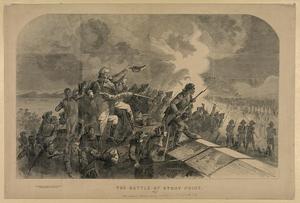
(Library of Congress)
Revolutionary War Battles
Paulus Hook
August: George Washington’s 1779 strategy was a mirror image of his British counterpart. Where General Clinton sought to draw out the Continental Army in the north, Washington sought to dodge the grand battle. Both generals resorted to small scale attacks that barely moved the needle that would have been a decisive blow. This template, with the exception of Savannah, was the model for actions in the south.
Thus, when Major Henry Lee approached General Washington with a plan to attack Paulus Hook (now Jersey City) modeled on the successful tactics of General Wayne at Stony Point, he was quick to approve the attack.. The “Hook” was separated from New York by the narrowest line of the North River (Hudson River) and occupied a strategic position. The fort constructed was separated from the Jersey mainland by swamp and only accessible by a narrow causeway.
Lee led 300 men through the marshy ground. It was 3 A.M. and the incoming tide was flooding the causeway. One of the major’s officers located an area that the force could ford. The attack on the fort began at about 4 AM. Approximately 30 minutes later the patriots controlled most of the fort. The British commander, William Sutherland, and some of his officers had secured themselves in another part of the fort. Dawn would expose the Americans to a counter attack from the strong British forces on the New York side. Thus they quickly gathered 158 prisoners and evacuated the fort. The Americans suffered 5 killed and wounded and the British 50 casualties besides those captured.
Major
Lee was affectionately known as “Light Horse Harry” as an
acknowledgement of his equestrian skills. One year later he received a
promotion to the rank of Lt. Colonel. The Continental Congress awarded
him a gold medal for his action at Paulus Hook. He would distinguish
himself as a major general at the battle of Guilford Courthouse 1781. His military lineage extended to Confederate General Robert E. Lee and the family tree included General Zachery Taylor, U.S. President 1849-1850.
|
Revolutionary War Battles 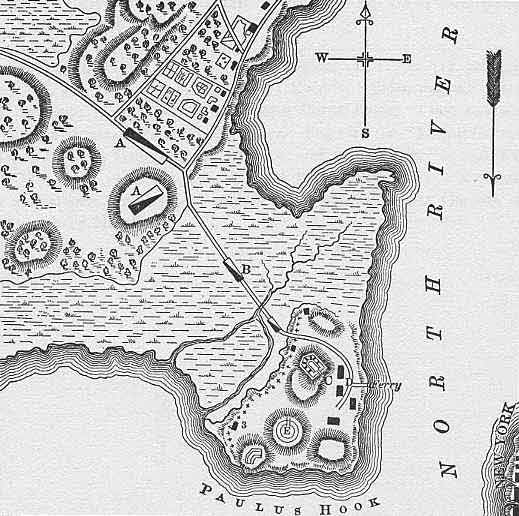 Revolutionary War Battles |
Revolutionary War Battles 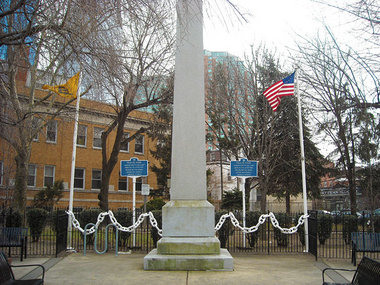 Site of the Fort---Jersey City (Al Frazza photo) |
September: During the early months of 1779, John Paul Jones commanded a fleet of four Continental naval vessels in European waters searching for British targets. They successfully captured 17 British ships. On the night of September 23, they were patrolling in the North Sea and spotted two men of war flying the English flag. He ordered his 3 other ships to give chase to the Countess of Scarborough. Jones engaged the other vessel, Serapis. The British ship, with its 44 guns, had the Americans aboard the Bonhomme Richard at a serious disadvantage. The captain of the Serapis, Richard Pearson, called on Jones “to strike its colors” and concede surrender. John Paul Jones replied, “I have not begun to fight”.
Jones rammed his vessel into the stern of the Serapis. His position prevented Jones from bringing his guns to bear on the Serapis. Jones lashed the boats together and unsuccessful attempts were made by the crew of each vessel to board the other ship. When one of the other vessels of the Jones fleet joined the battle, the British surrendered. The Bonhomme Richard was seriously damaged and sunk. Jones and his crew sailed the Serapis back to France-- a prize of war.
Revolutionary War Battles
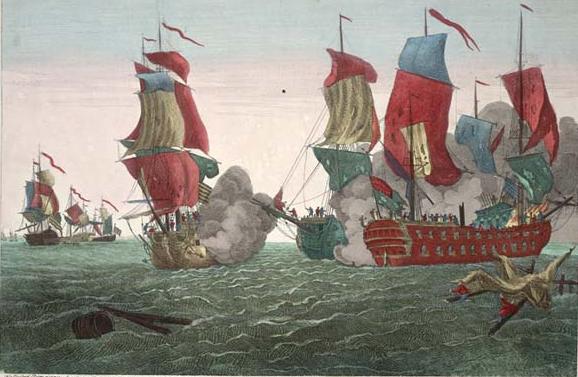
(Engraving based on painting of Richard Paton)
"The rest of the story"----1770
This Scottish born American patriot was baptized John Paul. He began his life at sea at the age of 13. Sheer skill and depth of maritime experience raised him to a captaincy of a British merchant vessel at an early age.
Possibly because of temperament or temper, and as a strict disciplinarian, he caused the death of a British seaman ordering a vicious flogging. Less than 2 years later, Captain Paul ran his sword through a seaman killing him in a wage dispute that Jones claimed threatened mutiny.
Fearing trial in a civil court for homicide, rather than an admiralty court, he abandoned his status as a valued commander in the British merchant fleet. He fled to Virginia where his brother resided. He then adopted the additional surname of Jones. Was he covering his tracks in a British colony?
Revolutionary War Battles
1780
April 14: General Clinton aimed his big guns on Charleston. He learned that a Continental supply train was nearing the city which was under his siege. Clinton ordered a force to intercept the Americans commanded by General Isaac Huger.
A detachment of Continentals were dispatched to Monck’s Corner to create a possible escape corridor for the Lincoln forces in Charleston. Monck's Corner, originally a rural trading post, was one of many small villages that dotted the South Carolina countryside.
Lt. Colonel Banastre Tarleton and his light cavalry legion were the spearhead of the British attack. They quickly routed the patriots whose casualties and prisoners totaled over 100 men while the British lost 2 men in a one sided contest (April 14). Both the supply train and Americans at Monck's corner were decimated. Tarleton had developed a quick strike force of Loyalists that were adept at raids and foraging for supplies. His reputation for harsh treatment of Americans was spreading through patriot ranks.
Revolutionary War Battles
Charleston
May 12 Charles Town (Charleston), South Carolina, with its huge port, was the largest city in the south. As early as 1776, the British unsuccessfully sought to wrest its control from patriot forces. With General Henry Clinton’s new southern strategy, he renewed an attack on Charleston. He landed 8,000 soldiers about 30 miles south of the city (February). By April, the British commenced a bombardment of Charleston which was defended by a mixed group of regulars and militia numbering about 3500 under the command of General Benjamin Lincoln. The city was being destroyed by the bombardment, and to save it from further destruction, Lincoln surrendered along with 5,000 Continental troops
Revolutionary War Battles
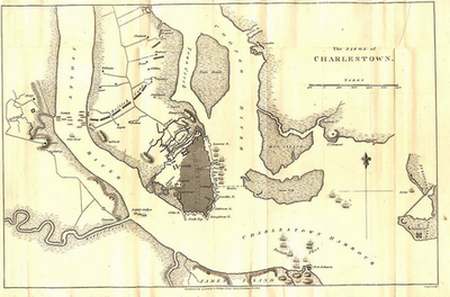
Revolutionary War Battles
This was the single greatest Continental loss of the war as the eponymous writer stated in his Moultrie Memoirs. General William Moultrie ,from his perch on Sullivan’s Island, observed the bombardment of Charleston on the night of May 11. He wrote, “It was a night of terror, and it broke the townspeople’s will to resist”. Thereafter, the hero of Fort Moultrie, that had been threatened by the earlier British attack four years earlier, surrendered his fort to the enemy. Admiral Mariot Arbuthnot, in an inspection tour of the fort, after its surrender, commented that he never seen such a secure fort for its size. He then understood the British failure in 1776 to still its guns.
May 29 Tarleton’s reputation for brutality was cemented in the Waxhaw region astride the borders of North and South Carolina. Colonel Abraham Buford was leading a small Continental contingent of 300 men away from the debacle of a surrendered Charleston. The British learned about the retreating Americans and sent Colonel Tarleton’s cavalry to catch them before they made good their escape. Tarleton caught up with the Continentals on the South Carolina side of the border. He reportedly sent ,under a flag of truce, a demand to surrender. Buford refused and set up a single line of defense in the typical European mode on the open battlefield. Buford sought the maximum advantage from the musket volley by holding fire until the enemy had almost reached his single defensive line. That was fatal for the Americans. They fired, and before they could reload, the Tarleton cavalry had crashed through the single line. Then, it is reported, that a flag of surrender was ignored, and the British proceeded to slash and stab to death the wounded already on the ground and clearly out of the battle.
Revolutionary War Battles
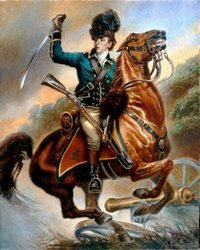
(A Georgia Junkie--Blog by Emery Lee)
Revolutionary War Battles
The massacre at
Waxhaw became an incentive for new recruitment. New enlistments increased
dramatically. The personal antipathy between patriots and the Loyalists widened
an already enormous gulf. The Americans had a long memory that included Tarleton.
July 13: Loyalists attempted a surprise attack on patriots camped at Cedar Springs, South Carolina. The Americans were forewarned and ambushed the attackers.
August 6: After the fall of Charleston, the British embarked on a plan to pacify South Carolina. Part of the strategy was to establish outposts in the back country. The patriots sought to harass these camps. They overran the British forces at Hanging Rock. The British losses were 192 and the American’s casualties were about 50.
Revolutionary War Battles
Camden
August 16: Charleston had fallen to the British forces about 3 months earlier and the Continental Army and their enemies were to again face each other in open battle. The British, under General Cornwallis, put 2,000 men in the field---mostly light infantry regiments. Opposing this army, General Horatio Gates began with a mixed force of about 4400 regulars and militia intending to dislodge the British from Camden, South Carolina. The antagonists chose a battlefield to the north east of Camden. The American forces were significantly diminished at the time of the battle by a wave of dysentery in the American camp. The battlefield was divided between the red coats that were clearly distinguishable from the American blue coats. The battlefield chosen by the Americans was an immediate disability as it lay between 2 swamps and narrowed the mobility of the Americans--- a potential trap without an escape route.
General Gates had garnered all the honors of a victor at Saratoga----much to the chagrin of Benedict Arnold who may have had a greater claim to the good fortune of the Americans at that venue. Now, on August 16, Gates made a fateful tactical error when he ordered an inexperienced force, without bayonets, to attack the British flank. The British had already planned to attack in the same area with fixed bayonets. The British routed the Americans and the Tarleton cavalry concluded the victory with a devastating attack on the rear of the American army. History records the fact that General Gates fled the battlefield when leadership was required. That escape essentially ruined his name and career which was officially ended by Washington in his letter to the Congress as follows: ---National Archives-Writings of George Washington 1745-1799, John C. Fitzpatrick, Editor.
Head Quarters, Prekaness, October 22, 1780.
Sir: I have the honor to inform Congress, that in consequence of their resolution of the 5th: instant, I have appointed Major General Greene to the command of the Southern Army, 'till the enquiry into the conduct of Major Genl. Gates is completed. I inclose a Copy of my instructions to General Greene, by which and a Copy of my letter to Genl. Gates, Congress will perceive the mode I have adopted for the enquiry. I did not perceive any other which could be substituted with equal propriety, but if Congress are of a different opinion, I submit it to them for their further directions.
I beg leave to mention General Greene, upon this occasion, to Congress as an Officer, in whose abilities, fortitude and integrity, from a long and intimate experience of them, I have the most intire confidence. In the command he is going into he will have every disadvantage to struggle with. The confidence and support of Congress, which it will be his ambition to merit, will be essential to his success. The defect of military resources in the southern department, the confusion in which the affairs of it must for some time be, require that the Commanding Officer should be vested with extensive powers. I dare say Congress will take their measures in a manner suited to the exigency. General Greene waits upon them for their orders.
As, in a great measure, a new Army is to be formed to the southward, the presence of the Baron de Steuben will in my opinion be of more essential utility in that quarter than here, where through the ensuing Campaign, we shall have the greatest part of our force raw Recruits, yet as we are organized and in some order, the sub-inspectors will suffice for the purposes of the department. I therefore submit to Congress the propriety of sending the Baron de Steuben to the southern Army, The sooner they are pleased to announce their pleasure on this head the better. I have the honor etc.
September 4: Britain’s Banastre Tarleton and his Tory Legion along with the American, Daniel Morgan, were acknowledged masters of the tactics demanded by the terrain. The former, slash and burn, the latter using the topography to conceal his riflemen.
However, Francis Marion, known as the “Swamp Fox” utilized hit and run tactics that presaged modern guerrilla warfare. In one action, he suddenly struck a larger British force crossing through a South Carolinian swampy region. His attack forced them to beat a hasty retreat. The British left behind 150 American prisoners taken at the battle of Camden and whom Marion freed.
September 25
Benedict Arnold, Commander of West Point garrison on the Hudson River,
his treason exposed with the capture of the spy, Major Andre, eluded
Americans and escaped to British Lines. His correspondence with his wife from his West
Point house in code established his treason. His wife, Peggy, was exposed as a devoted loyalist with close ties to British Major John Andre who was later captured and executed as a spy by the Continental Army October 2, 1780.
|
Revolutionary War Battles 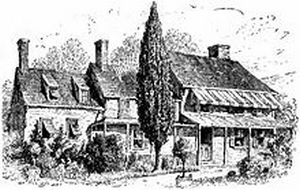 (Appelman's Cyclopaedia of American Biography 1900) |
Revolutionary War Battles 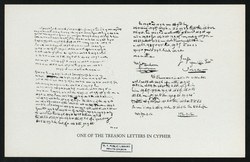 Arnold coded letter to his wife |
September 26:General Cornwallis felt confident about the British strategies in South Carolina. He may have been contemptuous of patriot activity dismissing it as insignificant. He now sought to extend his control of the population in North Carolina and aimed at Charlotte. He dispatched his cavalry to scout the town before he committed his force. They immediately drew fire from hidden patriots. Instead of returning to the British main camp to report the potential danger of an entrenched enemy, the cavalry committed itself to a calamitous charge against the well hidden Americans. They were hit by a devastating musket volley. Major Davie and his patriot force then withdrew from Charlotte and suffered 6 casualties against the 59 sustained by the British.
Revolutionary War Battles
King's Mountain
October 7 While Cornwallis moved the main body of his forces northward into North Carolina, British Major Patrick Ferguson sought to rally Loyalist sympathizers outside of the Cornwallis orbit. He focused on rural South Carolina. His assembled militia was attacked by patriots and Ferguson sought the protection of the Cornwallis army but could not reach their protective umbrella. A one hour battle ensued between contending militia leaving Ferguson dead along with almost his entire force of 1,000.
American casualties were under 100. The memory of the Waxhaw massacre found a “Remember the Alamo” moment and the battle was particularly bloody. Moreover, Ferguson had attached his Loyalist troops to Tarleton's regiment at the battle at Monck's corner, and that association exacerbated patriot enmity .In the aftermath of King's Mountain, at least a dozen Tories were hung in reprisal for Waxhaw.
Ferguson was known to have uttered, "I will lay your country waste with fire and sword". His legacy, if any, occurred prior to the war. He had invented a breech loading rifle. This was the only rapid firing weapon used in the war, and was used only by his regiment.
Revolutionary War Battles
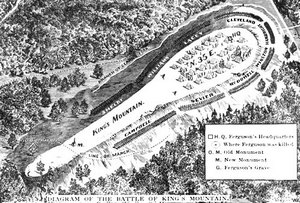
(Colonial Bytes)
October 14: General Washington appointed General Nathanael Greene as Commander of the Continental’s Southern department. This move replaced Generals Gates and Lincoln. They both had failed in the battles of Camden and Charleston. Greene’s army was severely depleted, but the patriot militias victory at King’s Mountain gave him some breathing room. King’s Mountain probably delayed the Cornwallis plan to move in force into North Carolina.
December 21: General Greene’s staff had been augmented with the newly minted Brigadier General Daniel Morgan. His reputation as a fierce fighter has been chronicled as far back as 1775 in Boston. Then , again, as a leader of sharpshooters at the second battle of Saratoga. He was ordered with a unit of 600 men to hook up with local militia to protect civilians in western South Carolina. That tactic gave him a formidable complement of about 1,000 men.
December: General von Steuben unsuccessfully attempted to ambush the turncoat, British Brigadier General Benedict Arnold, who successfully raided Continental military stores in Richmond, Virginia.
Revolutionary War Battles
1781
January 16: General Daniel Morgan realized that he was being chased by General Banastre Tarleton with a force of about 1000. He knew him to be aggressive, wily and a vicious fighter. Morgan believed that those qualities might benefit his mixed force of regular army and militia. He chose to stand and fight. He chose a site that was protected by a swollen creek on one side and a ravine on the other. This would negate flanking moves. He then chose a defensive plan that epitomized “out of the box” thinking. Tarleton took the bait and in the early A.M. on January 17 moved in for the kill.
Revolutionary War Battles
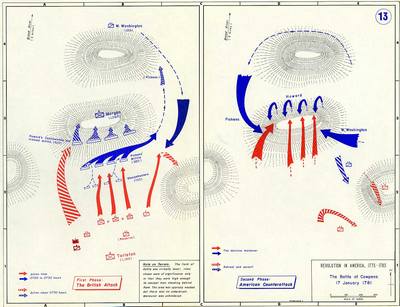
American Tactics Decides Battle
(Awsome Stories)
On its face, the tactic appeared to be the typical line formations that would seemingly be advantageous to the enemy's aggressive attack Morgan's first line was comprised of his riflemen who would fire a volley and appear to break, but in fact would reassemble in the rear. The second line would meet the British charge with a volley and fall back in apparent disarray. Waiting for the charging British was a third line stationed on a hill forcing the British to charge uphill. Morgan’s, secret weapon, his riflemen were ordered to “aim at the epaulets” and succeeding in killing 39 of 66 British officers. Morgan’s cavalry, at the opportune time, circled behind Tarleton’s charging troops and completed a double envelopment and killed and wounded 300 and took 600 prisoners. American casualties were about 150. (One historian analogized the strategy to Hannibal’s defeat of the Romans at Cannae ,216 bce).
Revolutionary War Battles
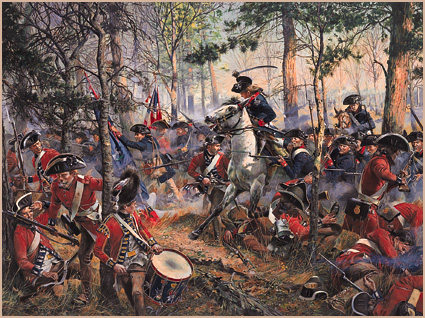
(Don Troiani)
Revolutionary War Battles
Revolutionary War Battles
Guilford Courthouse
March 15: General Cornwallis intended to cross into Virginia and end the southern war in that venue. General Greene was the obstacle and Cornwallis pursued the ever retreating American army into Virginia. The British halted at the North Carolina border to regroup and resupply. Greene believed the time was ideal to strike and re-crossed the Dan River. His plan was to implement the Morgan double envelopment at Cowpens two months earlier. Each of the three lines had dutifully discharged their volley, but the British kept advancing and engaged hand to hand. Cornwallis ordered grape shot fired indiscriminately although he was also striking his own men.
At the time that the ubiquitous Banastre Tarleton was ready to strike with his cavalry, Greene ordered his men to leave the field. On the basis of which army withdrew first, victory may have belonged to the British. However, in what may have lasted for an hour, Cornwallis had sustained substantial losses which his army could ill afford. This according to General Greene:
“Time will not permit me to be very particular, and therefore I shall only Confirm the account of there having been an action on the 15th. The battle was fought near Guilford Court House. It was long and severe. We gave up the ground and were obliged to leave our artillery, all the horses being killed. We retreated in good order....The Enemy loss is very great, much more than ours. We ought to have had a victory, and had your Militia stood by their officers it was certain. However the enemy have gained no advantage, except the ground and field pieces. Their operating force is diminished in such a manner, that I am not without hope of turning their victory into defeat, if the Militia don’t leave me”….
A somewhat different view from the opposing General Cornwallis:
“My Lord,
I
have the satisfaction to inform your Lordship that His Majesty’s Troops
under my command obtained a signal victory on the 15th Inst[ant] over
the Rebel Army commanded by General Greene....The conduct and actions of
the officers and soldiers that compose this little army will do more
justice to their merit than I can by words. Their persevering
intrepidity in action, their invincible patience in the hardship and
fatigue of a march of above 600 miles, in which they forded several
large rivers, and numberless Creeks, many of which would be reckoned
large rivers in any other country in the world, without tents or
covering against the climate, and often without provisions, will
sufficiently manifest their ardent zeal for the honor and interests of
their Sovereign and their Country....I have the honor to inclose(sic) to your Lordship the list of our killed and wounded”.
March: French allies engaged the British fleet in Chesapeake Bay. The battle was not determinative, but the French had a minor victory. Lafayette sought to join with the French in order to engage the British on land. However, the French predilection was, at the time, to engage the British on the seas.
April 30: Benedict Arnold, now a British general, was poised to attack Richmond, but Lafayette’s presence, in force, dissuaded the attack. General Cornwallis with 7,000 men sought battle with Lafayette who evaded the fight. Lafayette joined his regiments under General Wayne’s flag and they built a 4,000 man force.
June 26: Lafayette’s forces skirmished with the British in the area known as Spencer’s Ordinary, a tavern.
July:
General Washington planned to strike New York, the heart of Britain’s
American empire. He required the support of the French fleet to block
British reinforcement. Admiral de Grasse believed that the
Chesapeake area was the appropriate venue for a pitched battle. The
admiral had entrusted French interests in the Caribbean region to their
ally, Spain, and was committed to a southern strategy rather than far off New York. He was setting the agenda and Washington, of necessity, danced to the French tune.
August 21:The Americans and French agreed that the emphasis was Virginia. Washington laid plans with General Jean Baptiste Rochambeau to reinforce Lafayette. The former had command of a 5,000 man French force that he had brought to Rhode island in the prior year.
September 5: General Clinton
recognized the American intentions in Virginia and unsuccessfully
attempted to intercept and prevent French domination of the Chesapeake.
Clinton was forced to retire from the Battle of the Capes because of the superior French fire power. He returned his force to New York. The French Fleet now blockaded Virginia's York River and effectively blocked any Cornwallis retreat by sea. Cornwallis set his defenses at Yorktown. Virginia was his last stand.
Revolutionary War Battles
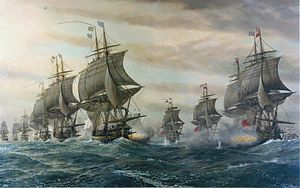
French and British battle off Virginia.
(V. Zveg----Hampton Roads Naval Museum)
Revolutionary War Battles
Revolutionary War Battles
Eutaw Springs
September 8: General Greene used his forces through the early part of the year systematically attacking and clearing British outposts throughout South Carolina. He contemplated recovering Charleston. Early in September he learned that Washington intended to confront Cornwallis at Yorktown, Virginia. His priorities shifted to reducing potential British reinforcements for Cornwallis in the north. He knew that some 2,000 British troops were in a camp near Eutaw Springs, an area well protected by swamps.
Revolutionary War Battles
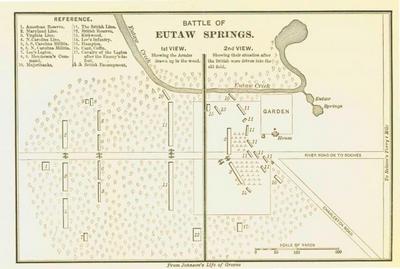
(USAMHI)
Revolutionary War Battles
Francis Marion, the “swamp fox”, knew the secluded, off map pathways and was able to navigate the patriots’ forces into a position to attack the encamped British who were breakfasting. A battle ensued with the Americans gaining the upper hand. The Americans who had been malnourished and ill clothed began to plunder the camp. The advantage then shifted to the British who counter attacked and drove off the Americans. There is a question as to who could claim the victory. Casualties were roughly equal. However, the British force withdrew to Charleston leaving the country side to the Americans.
Revolutionary War Battles
Yorktown
September 9: The French fleet, commanded by Admiral Comte de Grasse, was in control of the Chesapeake and disembarked 16,000 troops to oppose 6,000 (9,000 according to some historians) British. The window for Cornwallis for an orderly retreat, or escape, if necessary, was closing.
October 1: The French commenced the off shore bombardment joining the American guns on land targeted on the British defenses. The British had prepared a series of perimeter defenses, redoubts, that were well defended. Inexplicably, they abandoned two and the Americans quickly occupied them.
October 14: General Washington was determined to be aggressive. He ordered two columns to attack the remaining redoubts. Alexander Hamilton led a bayonet charge against 2 British defenses. When he gained these outer defenses, he succeeded in extending American lines to the York River. Cornwallis desperately attempted an escape by sea, but heavy storms destroyed the plan.
Revolutionary War Battles
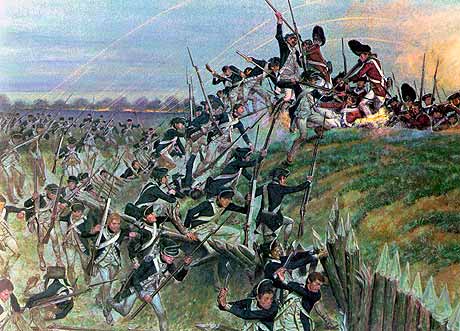
(British Battles. com)
Revolutionary War Battles
October 17: Cornwallis recognized the futility of further battle and requested the terms of surrender. Cornwallis did not attend the formal surrender ceremony claiming illness.
October 19: Cornwallis surrendered and the British forces were now prisoners of
war. Washington graciously paroled Cornwallis and his officers
permitting them to return to New York. Washington invited them to dinner
with one exception. General Banastre Tarleton was specifically
excluded. The Americans had a long memory about his alleged atrocities.
Revolutionary War Battles

Yorktown
Ode to Independence
December 20: Parliament recognized that it was not possible to continue the war. Treaty negotiations began with Benjamin Franklin in the lead role. The principles of independence, ceding continental territories and free access to international waterways formed the framework. Officially the war continued until the formal Treaty of Paris in 1783. Most of the action after 1781 was between the intractable enemies, France and Britain.
Total Casualties
The destructive toll of the war should be measured against the miniscule American population of 2.5 million in 1776. It is estimated that over the course of the war some 290,000 patriots served in the Continental Army or militia. It is further estimated that American deaths in captivity exceeded 8,000. In the era of peace that followed, the American population would grow to almost 4 million persons as determined by the census of 1790.
Forces - - - - - - - - - - - - --DEATHS- - - -OTHER DEATHS-----WOUNDED
American forces 290,000- - - - 6824- - - - - - - - 18,500 - - - - - - - - - - - - 15,000
British, German 125,000- - - - - No reliable
resources—
and Loyalists
Revolutionary War Battles Sources:
Cornwallis Compiled from Walter Clark, ed., State Records of North Carolina, vol. XVII (Goldsboro, N.C., 1899),
1002-1007]\\
Quoted from Richard k. Showman and Dennis M. Conrad, eds. The Papers of General
Nathaniel Greene, Vol VII (Chapel Hill, N.C.: University of North Carolina
Press, 1994) 448.
Memoirs of the American Revolution Moultrie,William. Google EBook and Georgia’s
Revolutionary War Trail; Georgia Sons of the American Revolution.
Troiani,Don. Images Courtesy of Military & Historical Image Bank
www.historicalimagebank.com
Revolutionary War Battles References:
American
Military History. Ed in Chief, Whiteclay, Chambers II. New York. Oxford
University Press, Inc. 1999.
Axelrod, Alan,
America’s Wars. New York.
John Wiley & Sons. 2002
Encyclopedia of the
American Revolution-Library of Military History. Second ed. Harold E.
Phillips, Charles &
Axelrod, Alan. Encyclopedia of Wars. Vol. A-F. Zenda. 2005.
Marley, David F. Wars of
the Americas.
Santa Barbara.
ABC-CLIO, Inc. 2008